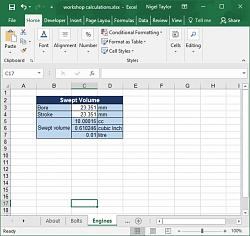I've probably lost half my potential audience by putting the word "math" in the title of this post; nevertheless most of what's here is simple enough that even the most rabid mathophobe shouldn't be frightened.
MENTALLY CONVERTING millimeters TO inches
The correct calculation is to divide mm by 25.4 (mm/inch) to obtain inches. 25.4 is close enough to 25 that dividing by 25 will come close to the right answer. Dividing by 25 is the same as multiplying by 4 and dividing by 100. So simply double the mm twice and move the decimal two places to the left.
Example: 73 mm => 4*70 + 4*3 => 280 + 12 => 292 => 2.92 in. (correct value = 73/25.4 = 2.87... in; 1.6% error)
Converting centimeters to inches is equally simple. A centimeter is 10 millimeters so proceed as above but move the decimal point only one place to the left.
Example: 31 cm => 4*30 + 4 => 124 => 12.4 in. (correct value = 31/2.54 = 12.20... in; 1.6% error)
MENTALLY CONVERTING meters TO yards or feet
To convert meters to yards we multiply by (39.37 / 36 =) 1.094 which can be approximated by 1.1. Multiplying by 1.1 is particularly easy; simply add one tenth of the value to the value.
Example: 123 m => 123 + 12.3 => 135.3 yards (correct value = 123 * 1.094 = 134.51... yards; 0.58% error)
A yard is 3 feet so one can first convert meters to yards and multiply the result by 3 or multiply the meters by 3.3 to obtain feet.
Example: 123 m => 3*100 + 3*20 +3*3 => 369 + 36.9 => 370 + 35.9 => 405.9 ft (correct value = 403.53... ft; 0.58% error)
MENTALLY CONVERTING kilograms TO pounds
A kilogram is 2.20462 pounds, which is close enough to 2.2 pounds for most purposes. As with meters-to-yards, multiplying by 2.2 is dead easy. Multiply by 2 and add the result with the decimal shifted left one place.
Example: 7.3 kg => 14.6 + 1.46 => 16.06 lb (correct value = 16.0937 lb; 0.21% error)
ACCURATELY APPROXIMATING PI
Every home shop should have a scientific calculator with built-in trig functions and value of pi. If you're in a situation where all you have available is a simple four-banger then you can either memorize pi or use one of the integer approximations. In grade school you probably learned 22/7
22 / 7 = 3.14286 (error = 0.04%)
which is only marginally better than rounding pi to two decimals, 3.14, which has an error of 0.05%
However, for really good accuracy, approximate pi by 355/113 which has an error of only 0.00001% ! This is about as close to the real value as you can get with integers that are easily remembered.
If you still have trouble remembering those numbers, consider this mnemonic... Write pairs of the first three odd numbers - 113355 - and divide down the middle into two numbers - 113 & 355. Now, with these two numbers in hand, if you can't figure out which to divide by which to get a number close to 3, there's no hope for you.


 LinkBack URL
LinkBack URL About LinkBacks
About LinkBacks


 Reply With Quote
Reply With Quote






Bookmarks